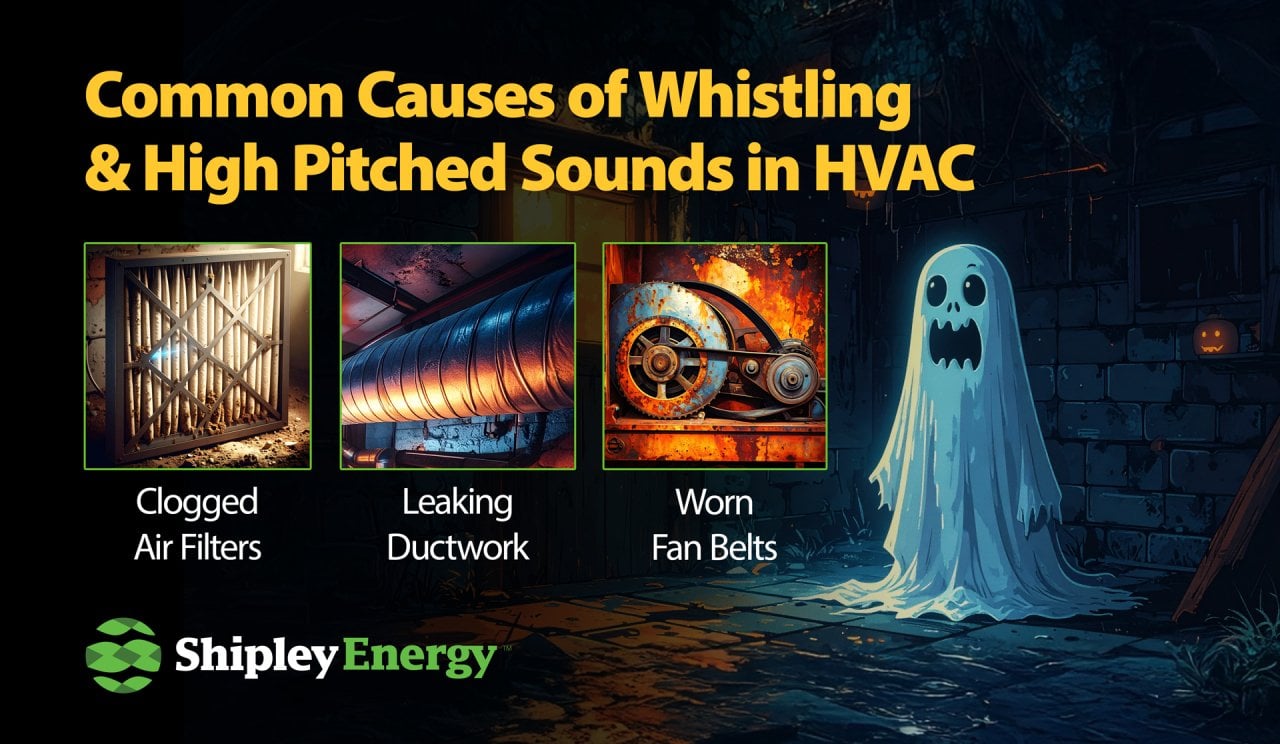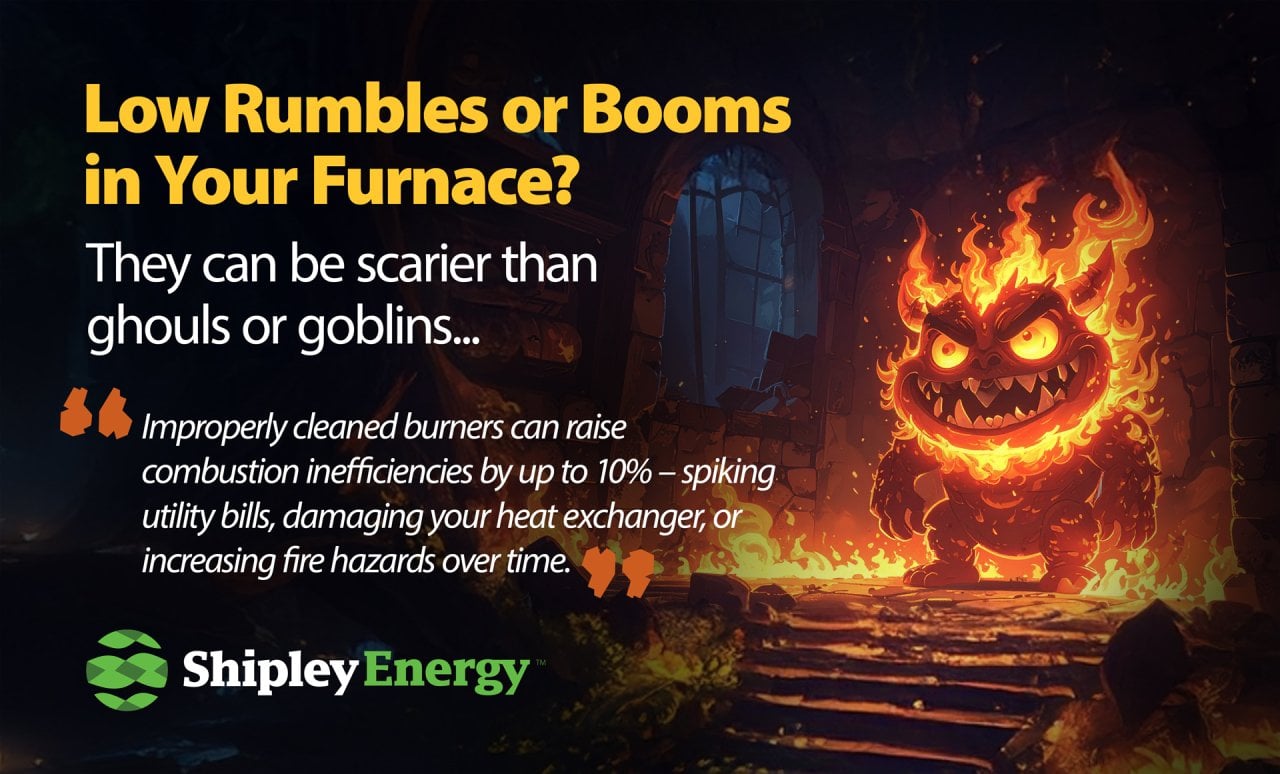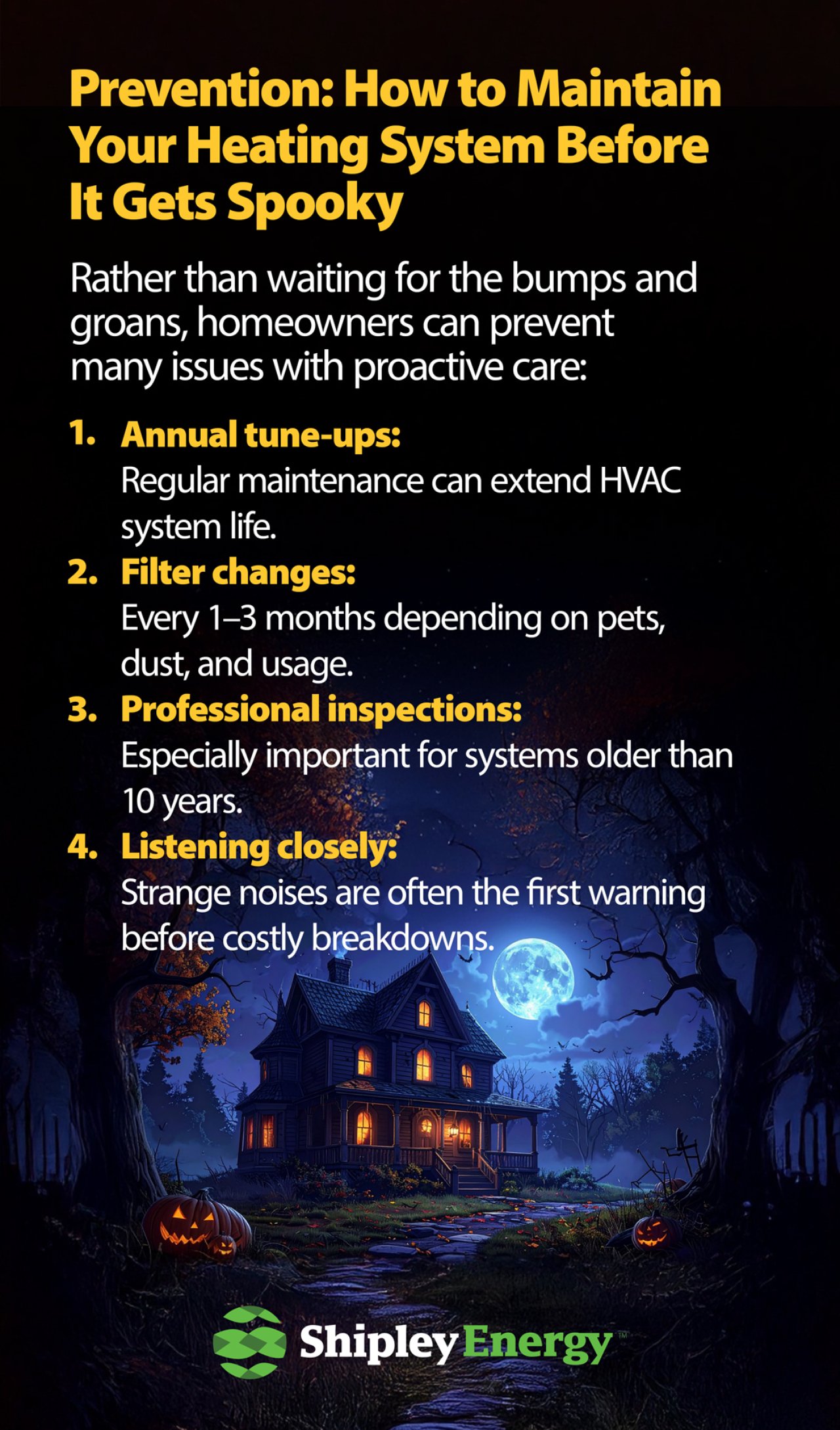When your heating system goes bump in the night: What those noises really mean

Stock-Asso // Shutterstock
Halloween is the season of haunted houses, shrieks, screams, and ghostly whispers. But if you’ve been startled by strange sounds echoing through your home, chances are you don’t need an exorcist—you need an HVAC technician.
The truth is that heating and cooling systems naturally make noise. Some sounds are harmless; others are red flags. And with nearly half of the average U.S. household energy bill tied to heating and cooling, keeping your system running efficiently is critical.
What’s more, system age is a major factor. The average furnace lasts 15–20 years, while central air conditioners typically last about 15 years. As systems approach these milestone ages, odd noises become increasingly common. Yet surveys show only 30% of homeowners routinely perform preventative maintenance—a costly gamble when many issues can be caught early through noise diagnostics and regular tune ups.
Shipley Energy breaks down the most common sounds, what they mean, and how to tell the difference between a seasonal creak and a serious problem.
Spooky Noises from Your HVAC System That Could be a Serious Issue
1. Banging or Knocking
What’s happening: Loud bangs when your system starts up often come from expanding ducts or loose blower components. More concerning is a condition called “delayed ignition,” where fuel builds up in the furnace before lighting all at once.
Why it matters:
- Ductwork expansion is normal—but repeated, sharp banging can damage connections.
- Delayed ignition wastes energy and can crack the heat exchanger, leading to carbon monoxide leaks.
Statistics in context:
- Furnaces over 15 years old are most likely to experience ignition delays.
- The Consumer Product Safety Commission reports that over 200 accidental CO deaths per year in the U.S. stem from malfunctioning heating equipment.
Homeowner checklist:
- Note when the bang happens: startup only (likely ducts) vs. throughout operation of equipment (needs service).
- Inspect for visible duct gaps or loose joints.
- If you smell gas or hear repeated booms, shut off your system and call a professional immediately.

Shipley Energy
2. Whistling or High-Pitched Sounds
What’s happening: Think of this as your system “trying to breathe through a straw.” Clogged air filters, leaking ducts, or worn fan belts restrict airflow and create whistling noises.
Why it matters:
- Energy.gov notes that dirty filters can significantly reduce energy efficiency.
- Prolonged restriction forces your blower motor to overwork, reducing lifespan.
Statistics in context:
- Homes with pets often need filters replaced every one to two months, not quarterly.
- Duct leaks are common: 20–30% of conditioned air is lost through leaks in typical homes.
Homeowner checklist:
- Replace filters every one to three months.
- Walk around your house: do some vents whistle more than others? That’s a duct leak clue.
- If whistling persists after filter changes, schedule a duct inspection.
3. Thumping or Rhythmic Vibrations
What’s happening: If it sounds like Frankenstein pacing upstairs, it’s often an unbalanced blower fan. Misalignment or debris caught inside can cause rhythmic vibrations.
Why it matters:
- Vibration wears down motor bearings and drives up energy use.
- Left unchecked, a several hundred dollar repair can become a $2,000 blower motor replacement.
Statistics in context:
- According to ASHRAE studies, unbalanced fans can cut motor life expectancy by half.
- Older systems with metal-on-metal mounts are most vulnerable.
Homeowner checklist:
- Does noise speed up as your fan ramps up? That’s a balance issue.
- Tighten screws on panels you can access safely.
- Avoid sticking hands into the blower—this requires professional realignment.

Shipley Energy
4. Low Rumbles or Booms
What’s happening: A furnace should ignite smoothly. If you hear low rumbles or boom-like sounds, burners may be dirty, causing uneven ignition.
Why it matters:
- Repeated booming can damage the heat exchanger and raise fire hazards.
- The NFPA notes that heating equipment is a leading cause of home fires in the U.S..
Statistics in context:
- Risk increases with furnaces over 15 years old.
- Improperly cleaned burners can raise combustion inefficiencies by up to 10%, spiking utility bills.
Homeowner checklist:
- Pay attention to repeated “mini explosions” at startup.
- Never attempt burner cleaning yourself—specialized tools are required.
- Schedule annual inspections and tune ups.
5. Gurgling or Dripping
What’s happening: This “haunted house drip” usually means a clogged condensate drain line, frozen evaporator coil, or both.
Why it matters:
- Backed-up water can overflow into your home, damaging drywall and flooring.
- Stagnant water encourages mold growth. The Mayo Clinic warns that indoor mold can worsen asthma and trigger respiratory symptoms.
Statistics in context:
- The EPA estimates 50% of U.S. homes have conditions favorable to indoor mold.
- AC systems more than 10 years old are particularly prone to condensate line blockages.
Homeowner checklist:
- Inspect your indoor unit for pooling water.
- Replace filters to prevent frozen coils.
- Ask your technician to flush drains and the condensation pump during annual service.
6. Rattling Panels or Loose Vents
What’s happening: Loose panels, unsecured ducts, or rattling vent covers can create persistent background noise.
Why it matters:
- While often harmless, leaks reduce efficiency significantly.
- Studies show proper duct sealing can reduce energy use by 20%-30%.
Statistics in context:
- Most homes built before 2000 lack advanced duct sealing.
- Modern “mastic sealants” can last 20+ years and dramatically reduce wasted airflow.
Homeowner checklist:
- Tighten screws on vent covers.
- Seal obvious leaks with foil tape or mastic (not standard duct tape).
- If rattling persists, have a technician test for hidden leaks.
7. Screeching or Squeaking
What’s happening: Screeching or squeaking could indicate an issue with a fan motor on your furnace or air conditioner.
Why it matters:
- Squeaking could be relatively harmless, and could indicate the need for a little bit of lubrication.
- Screeching is something to attend to quickly by calling your preferred HVAC partner, as your motor could wear and burn out unexpectedly leading to a costly repair.
Statistics in context:
- Aging systems are more susceptible to squeaking and screeching as lubrications and parts wear down over time.
- Worn bearings can lead to a blower motor replacement—costing up to $2,000.
Homeowner checklist:
- Have your system regularly maintained with annual inspections.
- Capture a video to send to your HVAC technician to give them context without them needing to make a diagnostic house call.
- Consider a protection plan to save on equipment repairs and replacements.

Shipley Energy
Prevention: How to Maintain Your Heating System Before It Gets Spooky
Rather than waiting for the bumps and groans, homeowners can prevent many issues with proactive care:
- Annual tune-ups: Studies show regular maintenance can extend HVAC system life considerably.
- Filter changes: Every one to three months depending on pets, dust, and usage.
- Professional inspections: Especially important for systems older than 10 years.
- Listening closely: Strange noises are often the first warning before costly breakdowns.
The Bottom Line
That eerie sound in the night probably isn’t a ghost—but it could be a warning from your heating or cooling systems. Some noises are harmless; others point to inefficiency, wear, or even safety hazards.
Ignoring them risks more than your comfort. It risks your health, your home, and your wallet. With heating and cooling accounting for nearly half of your home’s energy use, keeping your system in top shape is one of the most impactful steps you can take.
This story was produced by Shipley Energy and reviewed and distributed by Stacker.
![]()



